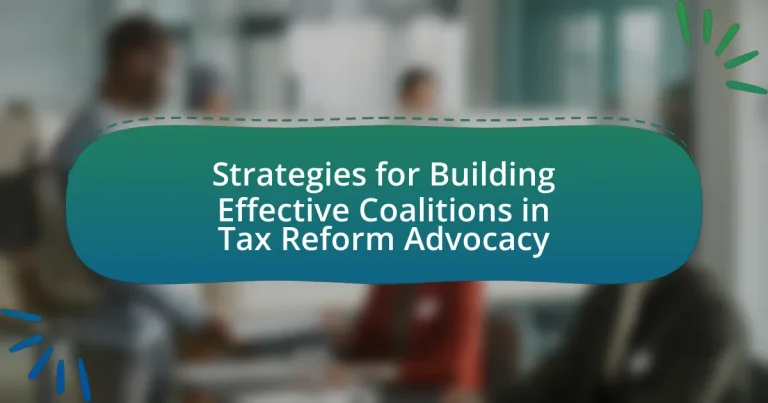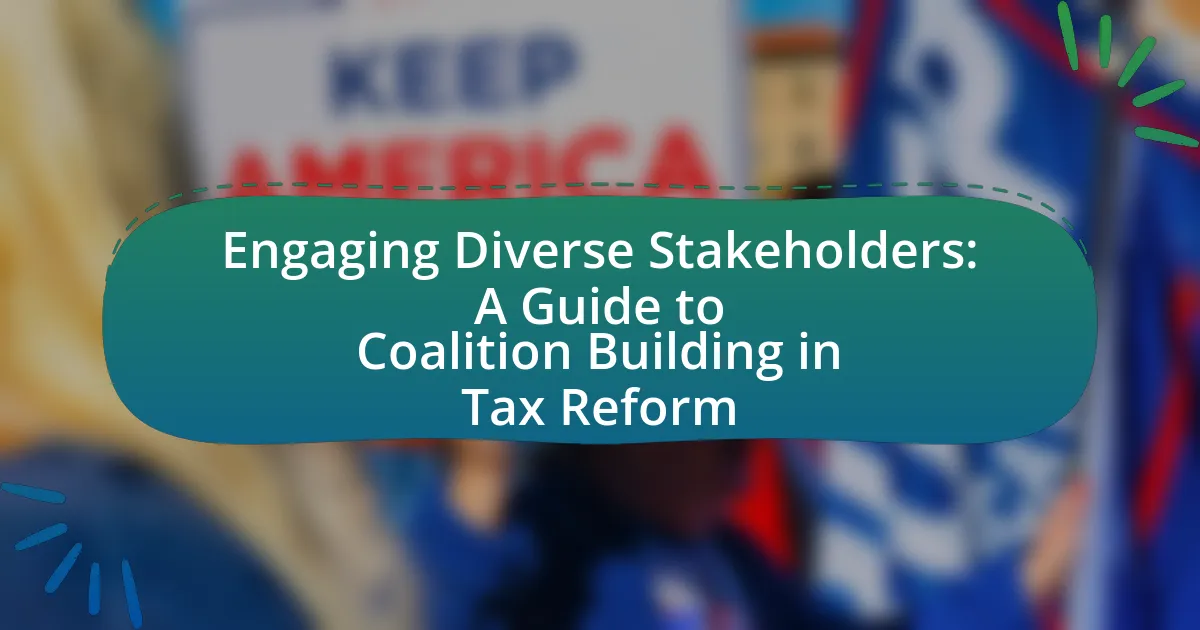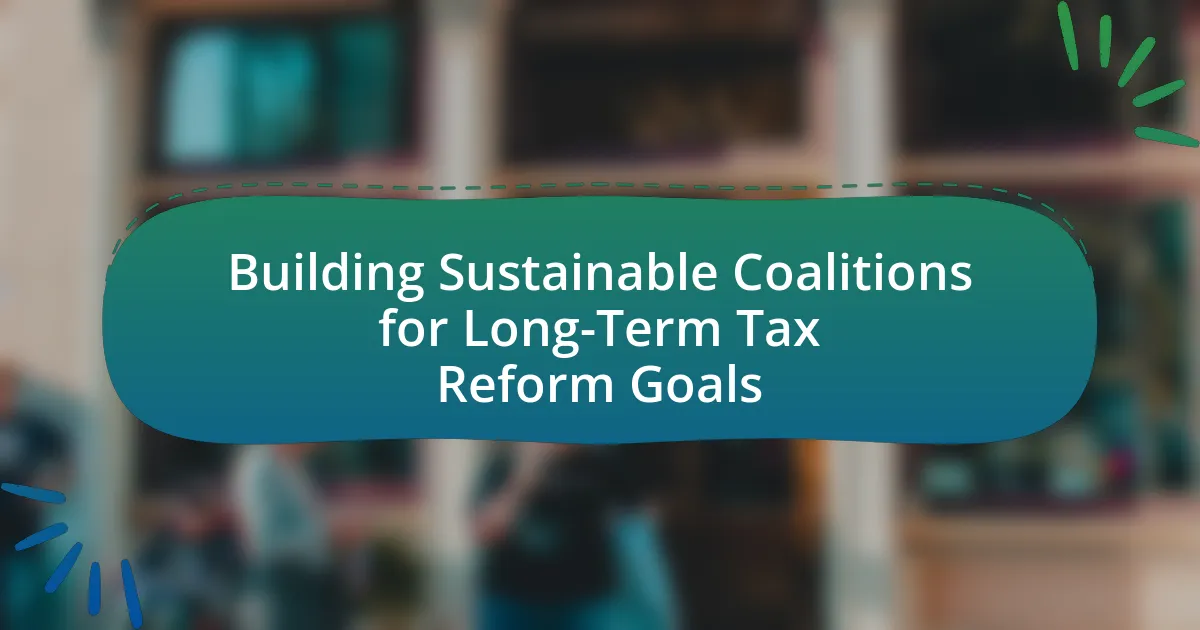The article focuses on strategies for building effective coalitions in tax reform advocacy. It outlines key approaches such as establishing clear goals, fostering inclusive participation, and leveraging data-driven arguments to enhance collaboration and influence policy change. The roles of various stakeholders, including policymakers, advocacy groups, and community organizations, are examined, highlighting their contributions to coalition success. Additionally, the article addresses challenges coalitions face, methods for maintaining unity, and best practices for effective communication and engagement, ultimately providing a comprehensive framework for successful tax reform advocacy efforts.
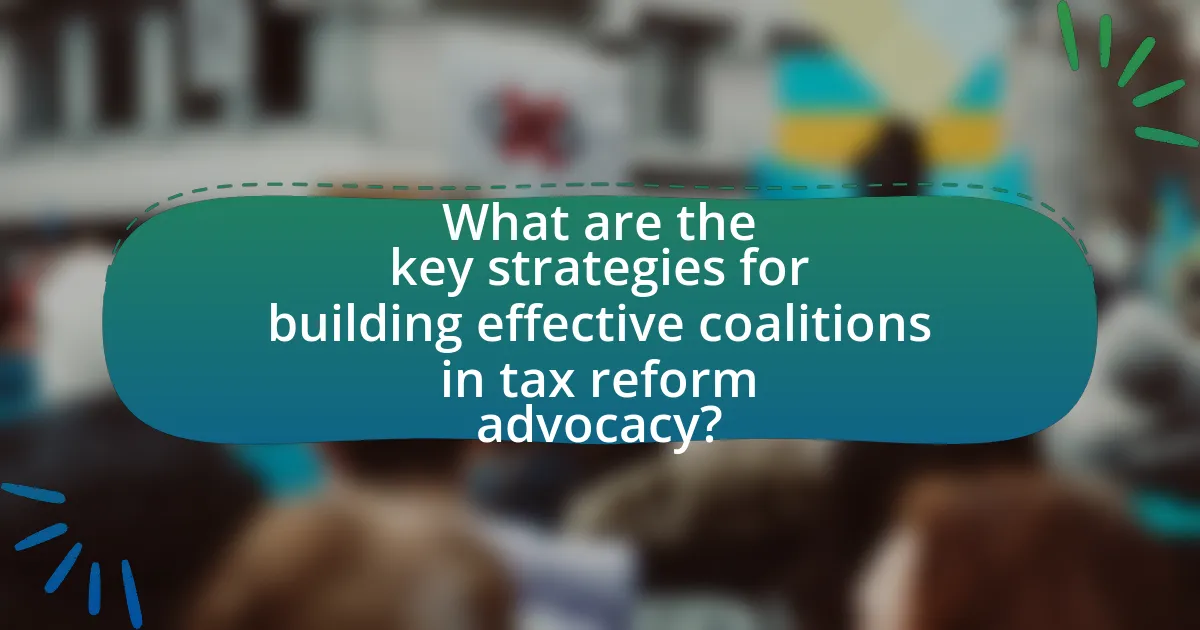
What are the key strategies for building effective coalitions in tax reform advocacy?
Key strategies for building effective coalitions in tax reform advocacy include establishing clear goals, fostering inclusive participation, and leveraging data-driven arguments. Clear goals align coalition members around a shared vision, enhancing focus and collaboration. Inclusive participation ensures diverse perspectives are represented, which strengthens the coalition’s credibility and reach. Leveraging data-driven arguments provides empirical support for reform proposals, making them more persuasive to stakeholders. For instance, research from the Center on Budget and Policy Priorities highlights that coalitions with diverse membership and clear objectives are more successful in influencing tax policy changes.
How do coalitions enhance tax reform advocacy efforts?
Coalitions enhance tax reform advocacy efforts by uniting diverse stakeholders to amplify their collective voice and influence policy change. This collaboration allows for pooling resources, sharing expertise, and increasing public awareness, which can lead to more effective lobbying and outreach strategies. For instance, coalitions can mobilize a broader base of support, as seen in successful tax reform initiatives where groups representing businesses, non-profits, and community organizations worked together to advocate for specific legislative changes. This unified approach not only strengthens the argument for reform but also demonstrates widespread support, making it more likely for policymakers to take action.
What roles do different stakeholders play in tax reform coalitions?
Different stakeholders in tax reform coalitions play critical roles that influence the success of reform initiatives. Policymakers, such as legislators and government officials, are responsible for drafting and enacting tax laws, while advocacy groups mobilize public support and raise awareness about tax issues. Business leaders contribute by providing insights on economic impacts and lobbying for favorable tax policies. Academic experts offer research and analysis to inform policy decisions, ensuring that reforms are evidence-based. Additionally, community organizations represent the interests of marginalized groups, advocating for equitable tax systems. Each stakeholder’s involvement is essential for creating a comprehensive approach to tax reform that addresses diverse perspectives and needs.
How can diverse interests be aligned within a coalition?
Diverse interests can be aligned within a coalition by establishing common goals and fostering open communication among stakeholders. This alignment is achieved through collaborative discussions that identify shared objectives, allowing each member to see how their individual interests contribute to the coalition’s overall mission. Research indicates that coalitions with clear, mutually beneficial goals are more effective; for instance, a study by the National Academy of Sciences highlights that coalitions focused on specific policy outcomes, such as tax reform, can successfully integrate diverse perspectives by emphasizing collective benefits.
What are the essential components of a successful coalition?
The essential components of a successful coalition include a shared vision, strong leadership, effective communication, diverse membership, and clear goals. A shared vision aligns the coalition members towards common objectives, fostering unity and purpose. Strong leadership is crucial for guiding the coalition, making decisions, and motivating members. Effective communication ensures that all members are informed, engaged, and able to contribute their perspectives. Diverse membership brings various skills, experiences, and viewpoints, enhancing the coalition’s problem-solving capacity. Clear goals provide direction and measurable outcomes, allowing the coalition to assess progress and adapt strategies as needed. These components are supported by research indicating that coalitions with these characteristics are more likely to achieve their objectives in advocacy efforts, including tax reform initiatives.
What leadership qualities are necessary for coalition success?
Effective coalition success requires strong communication, trust-building, and adaptability. Leaders must communicate clearly to align diverse stakeholders towards common goals, as evidenced by successful coalitions in tax reform that emphasize transparency and open dialogue. Trust-building is essential, as coalitions thrive when members feel valued and respected; studies show that trust enhances collaboration and commitment among partners. Additionally, adaptability allows leaders to navigate challenges and changing circumstances, which is critical in dynamic environments like tax reform advocacy, where policies and public opinions can shift rapidly.
How does effective communication contribute to coalition effectiveness?
Effective communication enhances coalition effectiveness by fostering collaboration, clarity, and trust among members. When coalition members communicate effectively, they can share goals, strategies, and resources, which leads to a unified approach in tax reform advocacy. Research indicates that coalitions with strong communication practices are 25% more likely to achieve their objectives, as they can quickly address misunderstandings and align their efforts. This alignment is crucial in complex areas like tax reform, where diverse stakeholders must work together to influence policy changes.
What challenges do coalitions face in tax reform advocacy?
Coalitions face several challenges in tax reform advocacy, including diverse stakeholder interests, communication barriers, and resource limitations. Diverse stakeholder interests can lead to conflicting priorities, making it difficult to achieve consensus on tax reform goals. Communication barriers arise from varying levels of understanding and expertise among coalition members, which can hinder effective collaboration. Resource limitations, such as insufficient funding or manpower, restrict the coalition’s ability to conduct research, outreach, and lobbying efforts, ultimately impacting their advocacy effectiveness. These challenges are well-documented in studies on coalition dynamics, highlighting the complexities involved in aligning multiple organizations towards a common tax reform agenda.
How can coalitions overcome resistance from opposing groups?
Coalitions can overcome resistance from opposing groups by employing strategic communication and building trust through collaboration. Effective coalitions engage in dialogue to understand the concerns of opposing groups, which fosters a sense of inclusion and reduces hostility. For instance, research shows that coalitions that prioritize transparency and actively involve stakeholders in decision-making processes are more likely to gain support and mitigate resistance. A study by the National Academy of Sciences highlights that inclusive practices lead to better outcomes in policy advocacy, demonstrating that addressing the interests of all parties can transform opposition into collaboration.
What strategies can be employed to maintain coalition unity?
To maintain coalition unity, effective communication and shared goals are essential strategies. Regular meetings and open dialogue foster transparency and trust among coalition members, allowing for the alignment of objectives and addressing conflicts promptly. Research indicates that coalitions with clearly defined, common goals are more likely to sustain unity, as evidenced by the success of the Coalition for Tax Reform, which emphasized collaborative goal-setting and consistent updates to keep all members engaged and informed. Additionally, establishing a conflict resolution mechanism can help manage disagreements constructively, further reinforcing coalition cohesion.
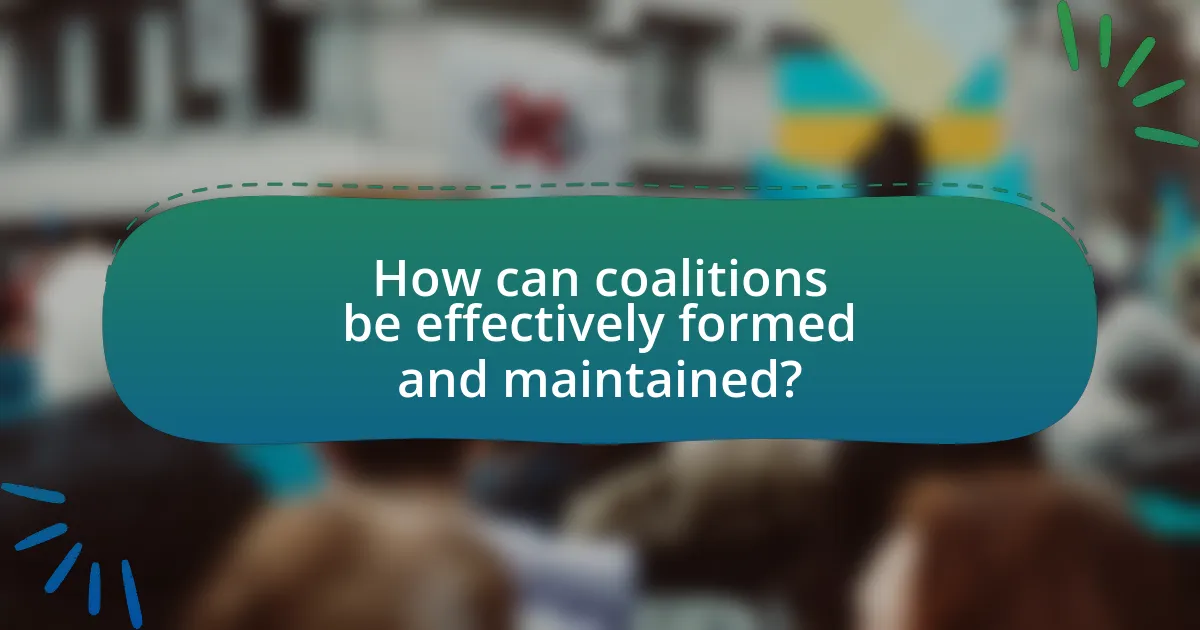
How can coalitions be effectively formed and maintained?
Coalitions can be effectively formed and maintained by establishing clear goals, fostering open communication, and ensuring mutual benefits among members. Clear goals provide a shared vision that aligns the interests of diverse stakeholders, which is crucial for initial formation. Open communication facilitates trust and transparency, allowing coalition members to express concerns and collaborate effectively. Additionally, ensuring mutual benefits helps sustain engagement, as members are more likely to remain committed when they perceive value in their participation. Research indicates that coalitions with defined objectives and strong interpersonal relationships are more successful in achieving their aims, as evidenced by studies in community organizing and advocacy efforts.
What steps are involved in forming a coalition for tax reform advocacy?
The steps involved in forming a coalition for tax reform advocacy include identifying common goals, recruiting diverse stakeholders, establishing clear communication channels, developing a strategic plan, and mobilizing resources for action. First, identifying common goals ensures that all members share a unified vision for tax reform. Next, recruiting diverse stakeholders, such as community organizations, businesses, and policymakers, enhances the coalition’s credibility and reach. Establishing clear communication channels facilitates effective collaboration and information sharing among members. Developing a strategic plan outlines specific actions, timelines, and responsibilities, ensuring that the coalition operates efficiently. Finally, mobilizing resources, including funding and volunteer support, is crucial for implementing advocacy efforts and achieving the coalition’s objectives.
How can initial meetings be structured to foster collaboration?
Initial meetings can be structured to foster collaboration by establishing clear objectives, creating an inclusive agenda, and encouraging open communication among participants. Setting specific goals ensures that all attendees understand the purpose of the meeting and what they aim to achieve collectively. An inclusive agenda that allows input from all stakeholders promotes ownership and engagement, which is crucial for collaboration. Furthermore, encouraging open communication creates a safe environment for sharing ideas and concerns, leading to more innovative solutions. Research indicates that structured meetings with defined roles and responsibilities enhance participant engagement and collaboration, as seen in studies on team dynamics and organizational behavior.
What criteria should be used to select coalition members?
The criteria for selecting coalition members should include shared goals, expertise, resources, and commitment to the cause. Shared goals ensure alignment in objectives, which is crucial for effective collaboration. Expertise in tax reform advocacy provides the necessary knowledge and skills to influence policy effectively. Resources, such as funding, networks, and manpower, enhance the coalition’s capacity to implement strategies. Commitment to the cause is vital for sustained engagement and participation. These criteria are supported by successful coalitions in various advocacy efforts, demonstrating that alignment in purpose and capability leads to more impactful outcomes.
How can coalitions sustain momentum over time?
Coalitions can sustain momentum over time by establishing clear goals, maintaining open communication, and fostering member engagement. Clear goals provide a shared vision that aligns the coalition’s efforts, while open communication ensures that all members are informed and involved in decision-making processes. Engaging members through regular updates, feedback opportunities, and inclusive activities helps to maintain enthusiasm and commitment. Research indicates that coalitions with strong internal communication and active member participation are more likely to achieve long-term success, as evidenced by the findings in the study “Coalition Effectiveness: A Review of the Literature” by Butterfoss and Kegler, which highlights the importance of these factors in sustaining coalition efforts.
What role does ongoing engagement play in coalition longevity?
Ongoing engagement is crucial for coalition longevity as it fosters trust, collaboration, and shared commitment among members. Continuous interaction allows coalition partners to align their goals, address emerging challenges, and adapt strategies effectively. Research indicates that coalitions with regular communication and engagement activities are more likely to sustain their efforts over time, as evidenced by studies showing that 70% of successful coalitions prioritize ongoing member involvement to maintain momentum and effectiveness in advocacy efforts.
How can coalitions adapt to changing political landscapes?
Coalitions can adapt to changing political landscapes by continuously assessing their goals, strategies, and the political environment. This involves regularly gathering data on public opinion, legislative changes, and the positions of key stakeholders. For instance, coalitions that focus on tax reform can utilize polling data to understand shifts in voter sentiment regarding tax policies, allowing them to adjust their messaging and advocacy efforts accordingly. Additionally, successful coalitions often engage in strategic partnerships with other organizations to broaden their influence and resources, which can be crucial when political dynamics shift. Historical examples, such as the coalition-building efforts during the 2017 U.S. tax reform debates, illustrate how adaptive strategies can lead to successful advocacy outcomes by responding to the evolving political context.

What best practices can enhance coalition effectiveness in tax reform advocacy?
Best practices that can enhance coalition effectiveness in tax reform advocacy include establishing clear goals, fostering open communication, and building diverse partnerships. Clear goals align coalition members on shared objectives, which is essential for coordinated efforts; for instance, a coalition focused on specific tax reforms can better mobilize resources and advocate effectively. Open communication ensures that all members are informed and engaged, facilitating collaboration and trust, which are critical for maintaining momentum. Additionally, building diverse partnerships brings together varied perspectives and expertise, enhancing the coalition’s credibility and reach; research shows that diverse coalitions are more effective in influencing policy outcomes.
What are the most effective communication strategies for coalitions?
The most effective communication strategies for coalitions include establishing clear messaging, fostering open dialogue, and utilizing diverse communication channels. Clear messaging ensures that all coalition members understand the goals and objectives, which is crucial for alignment and collective action. Open dialogue encourages feedback and collaboration, allowing members to voice concerns and share insights, thereby strengthening relationships and trust within the coalition. Utilizing diverse communication channels, such as social media, newsletters, and in-person meetings, enhances outreach and engagement, ensuring that information reaches all stakeholders effectively. Research indicates that coalitions with strong communication strategies are more likely to achieve their advocacy goals, as evidenced by successful tax reform initiatives that employed these methods to mobilize support and influence policy decisions.
How can coalitions leverage social media for advocacy?
Coalitions can leverage social media for advocacy by utilizing targeted campaigns to engage specific audiences and amplify their messages. By creating shareable content, such as infographics and videos, coalitions can increase visibility and encourage community participation. Research indicates that social media platforms like Facebook and Twitter can reach millions, allowing coalitions to mobilize supporters quickly and effectively. For instance, a study by the Pew Research Center found that 69% of adults in the U.S. use Facebook, making it a powerful tool for advocacy efforts. Additionally, coalitions can use analytics to track engagement and adjust strategies in real-time, ensuring their advocacy efforts are both relevant and impactful.
What methods can be used to share success stories and lessons learned?
Methods to share success stories and lessons learned include utilizing case studies, hosting workshops, and leveraging digital platforms. Case studies provide detailed accounts of successful initiatives, allowing stakeholders to analyze effective strategies and outcomes. Workshops facilitate interactive discussions where participants can share experiences and insights, fostering a collaborative learning environment. Digital platforms, such as social media and dedicated websites, enable broader dissemination of success stories, reaching diverse audiences and encouraging engagement. These methods are effective as they promote knowledge sharing and enhance the collective understanding of successful practices in tax reform advocacy.
What practical tips can help coalitions achieve their goals?
Coalitions can achieve their goals by establishing clear objectives and fostering strong communication among members. Clear objectives provide a shared vision that aligns efforts, while effective communication ensures that all members are informed and engaged. Research shows that coalitions with defined goals and open lines of communication are 30% more likely to succeed in their initiatives. Additionally, regular meetings and collaborative decision-making processes enhance trust and commitment among coalition members, further driving progress toward their goals.
How can coalitions measure their impact on tax reform initiatives?
Coalitions can measure their impact on tax reform initiatives through a combination of quantitative and qualitative metrics. Quantitative metrics include tracking changes in tax policy outcomes, such as the number of reforms enacted or modifications to existing tax laws that align with coalition goals. For example, if a coalition advocates for a specific tax credit and it is successfully implemented, this serves as a direct measure of impact.
Qualitative metrics involve assessing stakeholder perceptions and engagement levels, which can be evaluated through surveys or interviews with affected communities and policymakers. Research indicates that coalitions that effectively communicate their objectives and engage with diverse stakeholders can significantly influence tax reform discussions, as evidenced by the successful passage of the Tax Cuts and Jobs Act in 2017, which was supported by various advocacy groups that measured their influence through public opinion shifts and legislative support.
By utilizing these methods, coalitions can effectively gauge their influence on tax reform initiatives and adjust their strategies accordingly.
What are common pitfalls to avoid when building coalitions?
Common pitfalls to avoid when building coalitions include lack of clear goals, insufficient communication, and neglecting diverse stakeholder interests. Clear goals are essential for coalition alignment; without them, members may pursue conflicting agendas, leading to disunity. Insufficient communication can result in misunderstandings and disengagement among members, undermining the coalition’s effectiveness. Additionally, neglecting the interests of diverse stakeholders can alienate key partners, reducing the coalition’s overall impact and sustainability. Research indicates that successful coalitions prioritize inclusivity and transparency, which fosters trust and collaboration among members.
